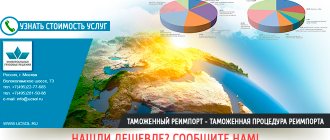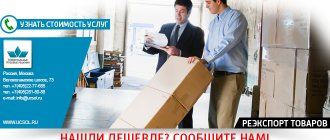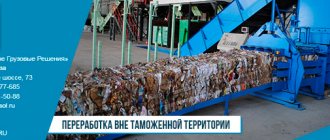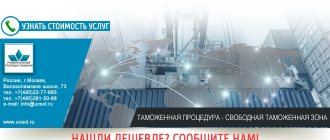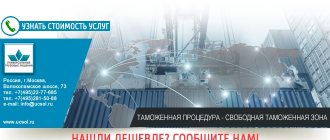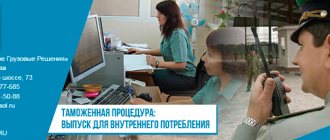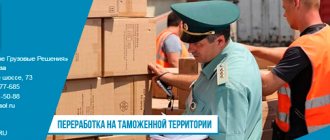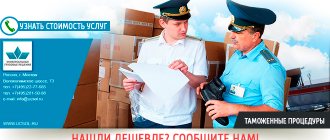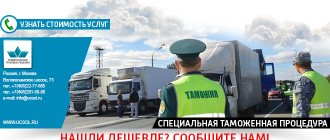Information on the topic. Here we will tell you about everything in more detail.
The legislation establishes that the customs regime for the re-import of goods can be applied to products that were exported earlier if they meet the following parameters: The goods were previously in the customs export regime or are a product of processing of goods that were in the processing regime on the customs territory; they are now being exported in re-export mode subject to a number of conditions:
- the time allotted for moving products under the re-import procedure is no more than three days from the day following the day of its movement across the customs border when exported from the Customs Union, in addition, there are other deadlines prescribed by law (see clause 2 of Article 293 of the Customs Code of the Customs Union) ;
- the condition of the product remains unchanged, in addition to changes due to natural loss, subject to the conditions of transportation, storage and operation, and natural wear and tear;
- the papers specified in Article 294 of the Customs Code of the Customs Union have been submitted to the customs authority;
The goods are in the temporary export regime, and the required terms have not expired, and the condition of the products is satisfactory (without changes except for natural wear and tear under normal conditions and changes permitted for goods under the temporary import procedure); The goods are subject to the customs procedure of processing outside the customs territory, while being imported within the processing period, all conditions for the unchanged condition of the product relative to the time of export from the customs territory of the Customs Union are met, in addition to changes due to natural wear and tear under normal conditions; The product is a product of processing of other goods previously placed under processing outside the customs territory for warranty repairs free of charge. Also, the placement of cargo under the customs procedure of re-import of goods is carried out within the period of its processing, with the exception of cases when, when releasing processed products for domestic consumption, it turned out to be necessary to take into account the presence of defects, which was the main reason for warranty repairs. It should be taken into account that according to Art. 293 of the Customs Code of the Customs Union, does not present an obstacle to the transfer of goods under the re-import procedure, using them outside the Customs Union to make a profit or carrying out measures to maintain its safety, including repairs (in addition to capital or modernization), maintenance, and other activities that serve to preserve consumer properties products, ensuring the unchanged condition of goods, such as at the time of removal from the territory of the Customs Union. An exception to this situation is repairs, after which the cost of the cargo relative to the day of removal from the territory of the vehicle has increased. Goods that were previously placed under customs regimes, which include subsequent export from the territory of the Customs Union, can be placed under the customs procedure of re-import of goods. Since the period for placing cargo under the re-import procedure is no more than three years from the date of the first export from the territory of the Customs Union, and the possibility of its extension is available only for some goods, you must be attentive to the time parameters if you want to apply the re-import procedure in the future, export and import goods from territory of the CU after a considerable time. Examples of re-import for clarity
The electric generator, exported a year earlier from the customs territory of the Russian Federation, was imported in June of this year as part of the re-import procedure. At the stage of cargo removal during the export procedure a year earlier, a VAT refund in the amount of 200 thousand rubles was made. Accordingly, when importing equipment and its customs clearance in June of this year, the company had to pay both customs clearance fees and VAT in the amount of 200 thousand rubles. As Georgian Finance Minister Alexi Aleksishvili said during a meeting with the heads of the country's key wine companies, the government made changes to the state's Labor Code to simplify the re-import of Borjomi wine and water from Russia. The changes cancel the requirements for payment of excise tax, VAT and customs duties in the case of re-import by Georgian companies. In addition, entrepreneurs are allowed to delay payment of taxes related to re-import in the amount of no more than 250 thousand lari (about $137 thousand) for a period of 3 months. Also, if the profit of a wine industry company decreases by 50% or more during 2006, it has the right not to pay income tax in a given year. According to the government's expectations, additional funds received from the application of benefits will be used by companies to promote products into new markets, and, in addition, to counteract the counterfeit of mineral water and wine. A resident enterprise of the Russian Federation (ZAVOD LLC, Nizhny Novgorod) bought from ) a transformer, which is an integral part of equipment for the production of fabrics, a weaving loom (hereinafter referred to as the product). The goods were imported through Domodedovo airport, cleared through customs, and installed as a fixed asset, but after 2 days the company’s specialists identified a manufacturing defect. In accordance with the warranty repair clause from the contract with the manufacturer under which this product was imported, the product could be accepted free of charge by the manufacturer for repairs if necessary. The manufacturer was also ready to replace it with similar new equipment or configure the existing one. At the same time, it should be remembered that in the case of paid repairs of equipment upon re-import, customs duties will be withheld from the company (the cost of repairs will in this case be the basis for the charge.
What is re-import
According to Art. 292 “Content and application of the customs procedure for re-import” of the Customs Code of the Eurasian Economic Union (EAEU Customs Code), re-import is a customs procedure applied to goods of foreign origin, according to which such goods, previously exported from the customs territory of the union, are imported back without payment import customs duties, taxes, special, anti-dumping, countervailing duties, subject to the conditions for placing goods under this customs procedure.
The re-import procedure is one of 17 existing procedures on the territory of the Russian Federation (their full list is presented in Article 202 of the Customs Code of the Customs Union “Types of customs procedures”).
The main provisions on re-import are enshrined in Chapter 31 of the EAEU Customs Code “Customs procedure for re-import”. Within the framework of this regime, certain requirements and conditions are established for organizations (for customs purposes only) that manage and use imported goods within the territory of the Customs Union (CU).
The re-import procedure is actively used when conducting foreign economic activity (FEA), since a company often has a need to import back goods that were previously exported from the vehicle.
The essence of the procedure
The essence of re-import is that items that previously left the vehicle are returned back within a certain period of time. At the same time, the entity carrying out this procedure has the right not to pay import duties and taxes - it is exempt from non-tariff regulation measures.
Items that fall under this procedure receive the status “released for free circulation.” Goods placed under the re-import regime can be used outside the Customs Union to make a profit or carry out measures to maintain its safety, including repairs (in addition to major or modernization), technical maintenance, and other activities that serve to preserve the consumer properties of products and ensure the unchanged condition of goods – the same as at the time of removal from the territory of the vehicle. An exception to this situation is repairs, after which the cost of the cargo relative to the day of removal from the territory of the vehicle has increased significantly.
Reference . Products that were previously subject to procedures that did not imply subsequent export from the territory of the Customs Union can subsequently be placed under re-import.
In what cases is it used?
Re-import does not fully apply to foreign trade operations, since they are not carried out intentionally. Re-import is used to implement re-import into the manufacturer's country, and the imported cargo should not be subject to additional processing.
Standard situations for its use include the return of goods that:
- rejected by the buyer;
- remained after sale at an auction, fair, exhibition, etc.;
- were not sold from consignment warehouses.
Range of services within the framework of registration of the re-import of goods regime
When completing this procedure, specialists provide a number of related services:
- Advise clients on various re-import issues;
- Study the list of goods that need to be brought back into the country;
- Provide information regarding required documents;
- Determine customs codes of goods;
- Fill out the declaration;
- Submit a declaration along with a package of accompanying documents to the customs authorities;
- Obtain permission from the customs inspection.
Conditions for placing goods under re-import
Products can be placed under the re-import regime only under the conditions set forth in Art. 236 of the EAEU Labor Code “Conditions for placing goods under the customs procedure of re-import”:
- If the product was intended for export, it is considered a processed product if the condition is met: re-import was started no later than three years from the date of movement of the product across the border.
- If it has not changed its original state except for the process of natural loss, if this is provided for in the conditions of transportation and storage. In this case, the customs authority must provide the relevant documents.
- If the cargo is in the process of temporary export, if the condition of meeting the deadlines is met, its condition has not changed.
- If it goes through the processing process outside the customs territory. It must be in its original, unmodified state. The probability of natural losses provided for by the conditions of movement and storage is taken into account.
- If the goods were obtained as a result of processing of the product outside the customs territory, if the processing was carried out free of charge or for warranty purposes.
Customs duties for re-importation are collected in the form of customs clearance fees. No concessions are applied to the duty if duty evasion occurred during the export.
What goods cannot be placed under re-import
So, it is prohibited to place the following goods under this regime:
- With foreign origin.
- From a Russian manufacturer, but exported from the Russian Federation under customs regimes other than export.
- Russian manufacturer, but brought under the export procedure with an expired re-import period at the time of their import back.
- Goods prohibited for import/export according to current legislation.
Stop searching!
We already have everything you need!
- Best price
- All countries and modes of transport
- All types of cargo and goods
- Convenient and fast communication
+7 (495) 478-00-48
Svetlana Markova
Foreign trade specialist
What goods cannot be placed under re-import
By means of logical exclusion, the scope of application of the re-import procedure is easily limited. Thus, the following goods cannot be placed under the re-import procedure:
- foreign origin;
- of Russian origin, but exported from the Russian Federation under customs regimes other than export;
- of Russian origin, imported under the export procedure, but with an overdue re-import period at the time of their import back;
- prohibited for import and export to the Russian Federation in accordance with established legislation.
Re-import and payments associated with it
As part of the customs procedure for re-importing goods, there is no obligation to pay taxes or duties to customs. However, one type of duties and taxes is still required by law to be paid to the government upon re-importation. The amounts that were previously returned to the re-importer at the time of export of goods from the territory of the Customs Union are paid, under conditions that meet the current legislation of the Russian Federation on taxes and fees. Thus, when the re-import procedure is applied to imported goods, the following payments are returned to the federal budget:
- taxes, import duties, as well as interest on taxes, if:
at the initial crossing of the customs border they were not charged (an example would be the re-import of processed products exported from the Customs Union before); due to the export of goods from the territory of the Customs Union, they were returned to the re-importer (this situation is observed when re-importing goods that were exported earlier during the export procedure, VAT is reimbursed for them based on the actual export from the territory of the Customs Union);
- subsidies, internal taxes, as well as other amounts that were not paid or were returned to the payer directly or indirectly as payments, benefits, compensation due to the export of goods from the vehicle.
The rules for calculating the amounts of customs duties for re-importation (import duties, as well as taxes) are prescribed in Art. 249 of the Customs Code of the Customs Union, which provides instructions for determining obligations to pay duties/taxes when releasing processed products into free circulation in the customs territory. So, if a re-import regime is applied to processed products obtained as a result of processing goods of foreign origin and previously exported from the customs territory of the Customs Union, the company has an obligation to pay duties and taxes to customs. In this case, the payments coincide with those paid by companies when importing products and further releasing them for domestic consumption, that is, if the processing regime for the goods had not been declared. The rates when calculating obligations for the refund of internal taxes are used as of the date of submission of the declaration for the export of goods from the territory of the Customs Union. Other values used in the calculation are the quantity of goods and its customs value indicated when exporting products from the territory of the Customs Union. As a result, when calculating internal taxes for refund, all values are taken into account on the day of compensation when exporting products from the territory of the Customs Union. The procedure for calculating the amounts of subsidies and other obligations that must be paid (returned) to the budget of the Russian Federation is established by the Government of the Russian Federation. In addition, it establishes cases in which the payment of interest in excess of these obligations is required. When calculating interest, the refinancing rate of the Central Bank of the Russian Federation is applied. Since at the moment there is no practice of issuing subsidies for the export abroad of goods produced in the Russian Federation (cases of application have not been established), the provision on the return of their amounts to the budget is not applicable. The return of money on account of duties paid to customs earlier upon import is regulated by Art. 295 of the Customs Code of the Customs Union, it is carried out if the products are imported into the territory of the Union in the re-import mode and within six months from the day following the day of export of the products from the territory of the Customs Union (formally crossing the customs border). This provision applies only if there is a fact that previously exported products have been subject to appropriate customs duties. All customs operations carried out within the framework of the re-import regime are regulated by Order of the State Customs Committee of the Russian Federation dated November 13, 2003 No. 1286 “On the performance of certain customs operations when using the customs re-import regime.” Taxes levied upon re-importation
It was previously stated that in the case of re-import of products within the framework of the customs procedure of re-import, taxes are paid to customs and there is no need to pay (Article 32). This rule is reproduced almost verbatim in clause 3.7 of the Regulations on the customs re-import of goods, but in this case taxes are not mentioned. Paragraphs 3.8 - 3.9 of this Regulation establish the procedure for the return (payment) of excise taxes and VAT when exporting products under the re-import procedure from the Russian Federation after January 1, 1992. This date is the beginning of the new taxation procedure for imported (exported) goods. This point has already been discussed in detail in the section on the customs regime (procedure) for release for free circulation. In this case, the question arises whether the given procedure for paying excise taxes and VAT from the Regulations contradicts the norms from the Labor Code, according to which re-imported products are exempt from taxes. In this case, it should be emphasized that the tax exemption for products prescribed in the Customs Code under the re-import regime applies only to excise taxes and VAT paid at the time of import into the territory of the Customs Union. In turn, the Regulation regulates “reverse withdrawal”, and not the payment of excise taxes and VAT, in the case of their previous return or exemption of products from them upon export. The calculation and payment of excise taxes and VAT refundable amounts are made at the rates current on the date of export of products, while the customs value for the purpose of calculating such amounts is applied as of the day of acceptance of the customs declaration, at which the products are placed for re-import. According to the provisions of the Labor Code, a person who moves goods under the re-import procedure returns all amounts that were received by him as payments or as part of other benefits provided to him at the time of export of products (Article 34). Such a requirement is undoubtedly justified from an economic point of view, and the procedure for paying excise taxes and VAT given in the Regulations is in full compliance with the provisions of the Labor Code, which regulate the return of benefits provided for the export of goods from the vehicle. According to Art. 5 of the Law of the Russian Federation “On Value Added Tax”, the list of goods exempt from VAT also includes goods sent for export. Letter of the State Customs Committee dated January 4, 1994 N 01-13/25 provides additional clarifications on the issue of payment (refund) of taxes. Taking into account these clarifications, it should be added that a number of VAT benefits do not apply to re-imported goods, in particular those that apply only to goods imported into Russia. When re-imported products upon export are exempt from VAT on the basis specified in the legislation (in addition to the exemption that exists for export), VAT is not subsequently applied, but the declarant is required to prove the fact of application of the tax exemption. If goods undergoing the re-import procedure are subject to excise tax, its amount is included in the base for calculating VAT. In this case, the excise tax is calculated at the rates for goods imported into the Russian Federation.
Procedure
Re-import is considered completed only after the customs officer puts the “release permitted” stamp on the declaration . To obtain this mark, permission to use this procedure is required. To do this, the interested party must fill out a cargo customs declaration (CCD) in accordance with the rules for declaring foreign products for free circulation and submit it to the Federal Customs Service (FCS). A declaration previously issued for exporting products abroad is also provided.
In addition, the declarant must provide the customs officer with evidence that he was not paid compensation for internal taxes when the cargo was exported from the country. And also prove that the product has not been changed abroad, as a result of which its value has increased. All documents must be prepared in advance so as not to encounter delays due to customs requirements to supplement the re-import application.
Important! Such requests are considered within 30 days.
What documents are needed
To place cargo under the re-import regime, the declarant must issue a customs declaration and the following list of documents:
- Data confirming the date the cargo crossed the border of the Russian Federation (as a rule, these are transportation documents).
- Information on payment or refund of funds for subsidies and internal taxes.
- Information about the repairs carried out in relation to the cargo (if it was carried out outside the Russian Federation).
- Documents confirming the export from the territory of the Russian Federation of a vehicle, spare parts and equipment for repairs or maintenance, as well as the fact that such repairs or maintenance were carried out with a vehicle exported outside the customs territory of the Russian Federation. At the same time, it is also verified that temporarily removed spare parts and equipment were used. This is relevant when placing under the re-import procedure spare parts and equipment included in the vehicle, which were replaced by equipment and spare parts temporarily exported from the Russian Federation.
- Documents similar to the previous ones confirming the conformity of the returned spare parts and equipment with those previously exported (for the case when the re-imported spare parts and equipment were not used for repairs).
- Information confirming the repayment of all amounts that should be returned upon re-importation into the federal budget. Presented with payment and other similar documents, accompanied by explanations for calculating the amounts paid, signed by the declarant.
- Letter from the Federal Customs Service of Russia on the extension of the period for placing goods under the customs procedure of re-import (if there is a need to extend the period of re-import).
- Information on the applicable standards, technical regulations and other similar regulations applied in the Russian Federation and defining the permissible limits of natural wear and (or) loss under normal conditions of transportation, storage or use (operation) of goods, in the event of a change in the condition of the goods during their stay outside the customs territory of the Russian Federation (at the request of the declarant).
All of the above documents must be provided at once in one package. They confirm the conditions under which the goods are placed under re-import. In their absence, customs has the right to refuse the declarant permission to re-import.
According to the general rule, if it is necessary to prove that there were no tax refunds when exporting products or repairs to goods that could lead to an increase in its value, this must be done by the declarant. Therefore, if there are no documents proving this, you will have to pay internal taxes and fees to the customs authorities.
Is it possible to extend the deadlines?
According to current legislation, the re-import period cannot exceed 3 years. An extension is permissible only in cases where certain types of equipment are involved. For example, this is equipment used in construction, production, as well as other devices without which it is impossible to carry out any complex processes.
The procedure for obtaining an extension of deadlines begins with the submission of an application. It can be drawn up in free form, but it is necessary to indicate the reasons for the export of products outside the customs union. The declarant has no more than 1 month to submit the application. You should also prepare the same documents as in the case of transferring goods to re-import mode.
Conclusion
Thanks to re-import, the recipient has the opportunity to send the purchased product back without financial loss. But for this it is necessary to comply with the conditions stipulated by the Customs Code of the Russian Federation. This is the only way to avoid having to pay customs duties and taxes again. Also, do not forget to comply with all product registration rules. Particular attention should be paid to the preparation of documents taking into account the specifics of the product.
Related posts:
- Import of goods - what does it mean, what types are there?
- Collection calculations - what does it mean, types, pros and cons
- Offer - what it is, types and example of design
- The law of supply and demand - what they depend on
- Invoice - what is it and how does it work?
- Cash on delivery - what is it and how does it work?
- Protectionism in the economy - what it is and how it works
- Distributor - what is it and how does it work?
Duty Refund
The declarant will be refunded the amounts paid in three cases:
- If the goods are exported and imported by the same payer of the export duty or if its payment was made in his favor.
- The applicant of goods registered for re-import provides customs officers with a written application for the return of the deposited funds.
- Customs officers received from the declarant a copy of the declaration (reasons for the accrual and payment of export customs duties), and the declarant was given confirmation from the customs authority that the funds were credited to his account.
Grounds for refusal
Reasons for refusal may include:
- a situation where the registration of re-import and return of payments was not carried out by the payer of customs payments, and this person does not have documents confirming his right to act on behalf of the payer;
- failure to comply with established deadlines (more than six months have passed, provided for the return of payments, or three years have passed for the application of the regime);
- the documents provided to customs contain false information;
- payments made during primary exports never reached the budget;
- the declared cargo contained prohibited items: precious metals, products made from them, military items, narcotic drugs, etc.
When can a refusal come?
According to the law, there are a number of grounds that may become an obstacle to the transfer of goods for re-import. The customs authority may exercise this right in the following cases:
- The one who submitted the documents and the person paying the customs duties are two different people who do not act as legal successors to each other;
- The applicant ignored the application deadlines;
- The person who filed the petition has debts regarding other customs procedures. In such a situation, the amount of this debt will be withheld, and the rest of the amount will be returned to the applicant;
- Paid duties have not yet been credited to the account or have not been cleared through the customs service;
- The application was signed by a person not vested with the appropriate official authority;
- The information that the applicant provided in the application turned out to be unreliable. Re-import may also be refused due to incomplete information provided about the need to return the cargo back abroad.
Example of a re-import procedure
A resident enterprise of the Russian Federation (ZAVOD LLC, Nizhny Novgorod) bought from ) a transformer, which is an integral part of equipment for the production of fabrics, a weaving loom (hereinafter referred to as the product). The goods were imported through Domodedovo airport, cleared through customs, and installed as a fixed asset, but two days later the company’s specialists discovered a manufacturing defect.
In accordance with the warranty repair clause from the contract with the manufacturer under which this product was imported, the product could be accepted free of charge by the manufacturer for repairs if necessary. The manufacturer was also ready to replace it with similar new equipment or configure the existing one. At the same time, it should be remembered that in the case of paid repairs of equipment upon re-import, customs duties will be withheld from the company (the cost of repairs will in this case be the basis for the accrual).
Re-export and re-import: what is the difference
The customs procedures for re-import and re-export are similar in that in both options the goods cross the border of the Customs Union twice. Re-export operations involve the export of goods previously imported into the country back abroad. In this case, the country into which the goods are imported and later exported is called the re-exporting country. An indispensable condition for the re-export operation is a minimal change in the goods in the re-exporting country, that is, any deep processing within the framework of this procedure is excluded. As an exception, such superficial changes as replacement of packaging materials, application of labeling are possible, aimed at bringing the product into compliance with the requirements of the country of destination, but without changing the original name and functionality of the product. If the share of changes made/new added value for a product intended for re-export exceeds the value threshold set at 50% of the export price, it is standard practice to change its sales name, such products can no longer be re-exported.
When carrying out a re-export operation, there is no mandatory requirement to import the goods into the territory of the transit country. An option is possible when the goods are sent directly to the importer’s country in accordance with the final details for shipment specified in the contract. The decision to import goods into the territory of the re-exporting state is made exclusively by the parties to the transaction (re-exporter and importer), taking into account the totality of the conditions for the operation (transport, customs, etc.). An exception, however, is the situation where there are any prohibitions on the part of the state in the field of selling specific products on its territory and exporting them to certain countries.
Re-import operations cannot be fully classified as foreign trade operations, due to the fact that they are not carried out intentionally. The content of the customs re-import procedure is that the goods are re-imported into the country of origin, while the exported goods do not have to undergo additional processing. The re-import regime is applicable to goods in a number of standard cases:
– return of goods rejected by the buyer;
– return of goods that could not be sold at fairs, auctions, exhibitions;
– return of goods that also could not be sold from consignment warehouses.
If there is a consignment condition, it is assumed that the ownership of the goods sold remains with the exporter while it is stored in a warehouse in the country of import. The transfer of ownership passes only upon sale of the goods. The typical storage period for consignment is 1-1.5 years. If during the specified period the sale of the goods did not take place, the stored products are returned (at the expense of the owner) to the exporter.
What is re-import as a customs procedure?
The customs procedure for the re-import of goods, presented in the Customs Code of the Customs Union (Chapter 39) and the Federal Law (Chapter 36), is applied in a situation where goods that previously left the Customs Union are imported back into its customs territory within a certain time frame (Article 293 of the Customs Code of the Customs Union) . At the same time, the person carrying out re-import does not have an obligation to pay taxes, import duties, and is not subject to non-tariff regulation measures.
The status of goods subject to the re-import procedure is determined as “released for free circulation.”
The customs procedure for the re-import of goods, according to the law, belongs to the final category, that is, during this customs regime, the end of the stay of products exported earlier outside the borders of the Customs Union occurs as a result of their import back into its customs territory.
The legislation establishes that the customs regime for the re-import of goods can be applied to products that were exported earlier if they meet the following parameters:
1) The goods were previously in the customs export regime or are a product of processing of goods that were in the processing regime in the customs territory; now they are being exported under the re-export regime subject to a number of conditions:
1. the time allotted for moving products under the re-import procedure is no more than three days from the day following the day of its movement across the customs border when exported from the Customs Union, in addition, there are other deadlines prescribed by law (see clause 2 of Article 293 of the Labor Code TS);
2. the condition of the product remains unchanged, in addition to changes due to natural loss, subject to the conditions of transportation, storage and operation, and natural wear and tear;
3. the papers specified in Article 294 of the Customs Code of the Customs Union have been submitted to the customs authority;
2) The goods are in the temporary export regime, while the required terms have not expired, and the condition of the products is satisfactory (without changes except for natural wear and tear under normal conditions and changes permitted for goods under the temporary import procedure);
3) The goods are subject to the customs procedure of processing outside the customs territory, while being imported within the processing period, all conditions for the unchanged condition of the product relative to the time of export from the customs territory of the Customs Union are met, in addition to changes due to natural wear and tear under normal conditions;
4) The product is a product of processing of other goods previously placed under processing outside the customs territory for warranty repairs free of charge. Also, the placement of cargo under the customs procedure of re-import of goods is carried out within the period of its processing, with the exception of cases when, when releasing processed products for domestic consumption, it turned out to be necessary to take into account the presence of defects, which was the main reason for warranty repairs.
It should be taken into account that according to Art. 293 of the Customs Code of the Customs Union, does not present an obstacle to the transfer of goods under the re-import procedure, using them outside the Customs Union to make a profit or carrying out measures to maintain its safety, including repairs (in addition to capital or modernization), maintenance, and other activities that serve to preserve consumer properties products, ensuring the unchanged condition of goods, such as at the time of removal from the territory of the Customs Union. An exception to this situation is repairs, after which the cost of the cargo relative to the day of removal from the territory of the vehicle has increased.
Goods that were previously placed under customs regimes, which include subsequent export from the territory of the Customs Union, can be placed under the customs procedure of re-import of goods.
Since the period for placing cargo under the re-import procedure is no more than three years from the date of the first export from the territory of the Customs Union, and the possibility of its extension is available only for some goods, you must be attentive to the time parameters if you want to apply the re-import procedure in the future, export and import goods from territory of the CU after a considerable time.
Examples of re-import for clarity
1) An electric generator, exported a year earlier from the customs territory of the Russian Federation, was imported in June of this year as part of the re-import procedure. At the stage of cargo removal during the export procedure a year earlier, a VAT refund in the amount of 200 thousand rubles was made. Accordingly, when importing equipment and its customs clearance in June of this year, the company had to pay both customs clearance fees and VAT in the amount of 200 thousand rubles.
2) As Georgian Finance Minister Aleksi Aleksishvili said during a meeting with the heads of the country’s key wine companies, the government made changes to the state’s Labor Code to simplify the re-import of Borjomi wine and water from Russia. The changes cancel the requirements for payment of excise tax, VAT and customs duties in the case of re-import by Georgian companies. In addition, entrepreneurs are allowed to delay payment of taxes related to re-import in the amount of no more than 250 thousand lari (about $137 thousand) for a period of 3 months. Also, if the profit of a wine industry company decreases by 50% or more during 2006, it has the right not to pay income tax in a given year.
According to the government's expectations, additional funds received from the application of benefits will be used by companies to promote products into new markets, and, in addition, to combat counterfeiting of mineral water and wine.
3) A resident enterprise of the Russian Federation (ZAVOD LLC, Nizhny Novgorod) bought from ) a transformer, which is an integral part of equipment for the production of fabrics, a weaving loom (hereinafter referred to as the product). The goods were imported through Domodedovo airport, cleared through customs, and installed as a fixed asset, but 2 days later the company’s specialists identified a manufacturing defect. In accordance with the warranty repair clause from the contract with the manufacturer under which this product was imported, the product could be accepted free of charge by the manufacturer for repairs if necessary. The manufacturer was also ready to replace it with similar new equipment or configure the existing one. At the same time, it should be remembered that in the case of paid repairs of equipment upon re-import, customs duties will be withheld from the company (the cost of repairs will in this case be the basis for the charge.
How to extend the re-import period
By law, re-import cannot last longer than three years. However, for certain categories of equipment, an extension of this period is allowed. These include equipment used for construction, mining, industrial production, as well as similar devices for other similar purposes.
To extend the period, you need to submit an application to the Federal Customs Service of the Russian Federation. It is written in any form and contains all the circumstances of the export of products from the territory of the Customs Union. The deadline for submitting it is 30 days before declaring the goods. Along with the request, the same package of documents is submitted as for the initial registration of re-import.
Note. It takes no more than 30 days to consider the request.
In the event that the package lacks any information or documents required to make a final decision on the issue of extending the period, the department of the Federal Customs Service of the Russian Federation competent in the field of application of customs procedures within fifteen days (from the date of receipt of the request) sends a written notification to the interested person about the need entering additional information and documents. From the moment of additional submission of the requested information and documents, 15 days are allotted for consideration of the request.
To formalize the extension of the period, the Federal Customs Service of the Russian Federation sends letters to both the sender of the reasoned request and the customs office that controls the region where the re-imported goods will be declared.
If the sender of a reasoned request refuses to extend the period, the Federal Customs Service of the Russian Federation sends a letter explaining the reason for the refusal.
Required documents
Documents are submitted 30 days before declaration, customs authorities consider the request no more than 30 days. If re-import is refused, customs authorities issue a documentary response or request additional documents. Re-import is possible if the consignment was exported no more than 3 years ago. But for some types of deliveries there are other deadlines provided by customs.
- a statement in free form, which describes all the actions and circumstances of import;
- documentation indicating the fact and rights of crossing the border of the customs union;
- information on repairs carried out abroad of the customs union (if any);
- customs declaration during transportation.
The placement of goods under the customs procedure begins from the moment the customs declaration or application for release is submitted to the customs authority until the declaration is submitted for the consignment. In this case, these documents must be submitted to the customs authority no later than one month before applying the product declaration procedure.
If you want to get a guaranteed result during customs clearance in this difficult regime, trust a professional customs representative with many years of experience in TAISU-TB. An integrated approach will allow you to obtain maximum financial benefits and avoid conflicts with supervisory authorities when exporting goods.
- Turnkey customs brokerage services for entrepreneurs and legal entities;
- TAISU-TB company is one of the 20 leading Customs Representatives of the Russian Federation;
- The average work experience of specialists is 15 years of continuous work;
- Portal for online tracking of registration stages;
- Wide geography of places of customs activity (Moscow, Smolensk, Bryansk, St. Petersburg, Vyborg, Vladivostok, Nakhodka, Novorossiysk, Kaliningrad);
- Assistance in obtaining permits: certificates and classification decisions.
